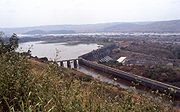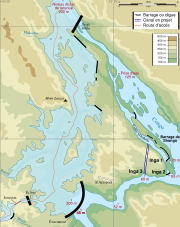
Inga Dam
Encyclopedia



Democratic Republic of the Congo
The Democratic Republic of the Congo is a state located in Central Africa. It is the second largest country in Africa by area and the eleventh largest in the world...
140 miles southwest of Kinshasa
Kinshasa
Kinshasa is the capital and largest city of the Democratic Republic of the Congo. The city is located on the Congo River....
, are hydroelectric dam
Dam
A dam is a barrier that impounds water or underground streams. Dams generally serve the primary purpose of retaining water, while other structures such as floodgates or levees are used to manage or prevent water flow into specific land regions. Hydropower and pumped-storage hydroelectricity are...
s on the largest waterfalls in the world, Inga Falls
Inga Falls
Inga Falls is a rapids 40 km from Matadi in the Democratic Republic of the Congo where the Congo River drops 96 m over the course of 15 km ....
. Here the Congo River
Congo River
The Congo River is a river in Africa, and is the deepest river in the world, with measured depths in excess of . It is the second largest river in the world by volume of water discharged, though it has only one-fifth the volume of the world's largest river, the Amazon...
drops 96 metres and has an average flow of 42,476 m³/s.
Current dams
Currently, the two hydroelectric dams, Inga I and Inga II, operate at low output. The existing dams are famous white elephantWhite elephant
A white elephant is an idiom for a valuable but burdensome possession of which its owner cannot dispose and whose cost is out of proportion to its usefulness or worth...
s, with total installed capacity 1,775 MW, of former Président Mobutu Sese Seko
Mobutu Sese Seko
Mobutu Sese Seko Nkuku Ngbendu wa Za Banga , commonly known as Mobutu or Mobutu Sese Seko , born Joseph-Désiré Mobutu, was the President of the Democratic Republic of the Congo from 1965 to 1997...
, part of the Inga-Shaba
Inga-Shaba
The Inga–Shaba EHVDC Intertie is a high-voltage direct current overhead electric power transmission line in the Democratic Republic of Congo, linking the Inga hydroelectric complex at the mouth of the Congo River to mineral fields in Shaba...
project. They also served a political purpose, by allowing Kinshasa to control the energy supply of the sometimes rebellious Shaba province.
Expansion plans
Plans are underway to rehabilitate the two dams. Also, there are plans for Inga III and Grand Inga, two massive new hydroelectric stations.Projections indicate that Inga III would generate 4,500 megawatts of electricity. Inga 3 is the centerpiece of the Westcor partnership, which envisions the interconnection of the electric grids of the DRC, Namibia
Namibia
Namibia, officially the Republic of Namibia , is a country in southern Africa whose western border is the Atlantic Ocean. It shares land borders with Angola and Zambia to the north, Botswana to the east and South Africa to the south and east. It gained independence from South Africa on 21 March...
, Angola
Angola
Angola, officially the Republic of Angola , is a country in south-central Africa bordered by Namibia on the south, the Democratic Republic of the Congo on the north, and Zambia on the east; its west coast is on the Atlantic Ocean with Luanda as its capital city...
, Botswana
Botswana
Botswana, officially the Republic of Botswana , is a landlocked country located in Southern Africa. The citizens are referred to as "Batswana" . Formerly the British protectorate of Bechuanaland, Botswana adopted its new name after becoming independent within the Commonwealth on 30 September 1966...
, and South Africa
South Africa
The Republic of South Africa is a country in southern Africa. Located at the southern tip of Africa, it is divided into nine provinces, with of coastline on the Atlantic and Indian oceans...
. The World Bank
World Bank
The World Bank is an international financial institution that provides loans to developing countries for capital programmes.The World Bank's official goal is the reduction of poverty...
, the African Development Bank
African Development Bank
The African Development Bank Group is a development bank established in 1964 with the intention of promoting economic and social development in Africa...
, the European Investment Bank
European Investment Bank
The European Investment Bank is the European Union's long-term lending institution established in 1958 under the Treaty of Rome. A policy-driven bank, the EIB supports the EU’s priority objectives, especially European integration and the development of economically weak regions...
, JFPI Corporation
JFPI Corporation
JFPI Corporation is an international closed-end investment and economic empowerment conglomerate based in Africa.While 100% of the shares are owned by private individuals, it is managed by a 53-member Board of Directors, representing each nation contained by Africa.JFPI promotes the growth of...
, bilateral donors and the southern African power companies have all expressed interest in pursuing the project, estimated to cost USD $80 billion.
Grand Inga would generate 39,000 MW - very significant to boost the energy needs of the Africa
Africa
Africa is the world's second largest and second most populous continent, after Asia. At about 30.2 million km² including adjacent islands, it covers 6% of the Earth's total surface area and 20.4% of the total land area...
n continent at a cost of $80 billion. Connecting Inga to a continent-wide electricity grid for main population centres would cost $10 billion more (est. 2000). This would be the world's largest hydroelectric project. Critics contend the huge amounts of money required for the project would be better spent with smaller scale, localized energy projects that would target meeting the needs of Africa's poor majority.
The NEPAD (New Partnership for Africa's Development) with a great involvement of South African electric power company ESKOM has suggested to start the Grand Inga project in 2010. With a capacity of 39GW the big dam can produce annually 250 TWh alone for a total of 370 TWh for the whole site. In 2005 Africa produced 550 TWh (600 kWh per capita). If the dam was to be completed somewhere in the 2020s the continent may be producing more than 1000 TWh at the time making its contribution less than 20% (still significant though).
Africa's electric energy disparity
The electric energy disparity in the continent makes Africa between the tropics the most in need of many small or big energy projects equivalent to Great Inga. The 550 TWh were produced in 2005 as follows:- 230 TWh (42%): South Africa with 5.5% of the continent population (4500 kWh per capita)
- 150 TWh (27%): Five northern African nations with 16.7% of the continent population: Egypt, Algeria, Morocco, Tunisia and Libya (1000 kWh per capita)
- 170 TWh (31%): The rest of the continent or intertropical Africa with 77.8% of the continent population (250 kWh per capita)
This is an average power of 63 GW to be compared to the 43.5 GW the Inga and the Grand Inga would generate.
There is a common false belief saying that the Grand Inga can produce enough electricity for the whole continent.http://www.theaustralian.news.com.au/story/0,20867,21396540-30417,00.html That was true before the 1990s.http://ieeexplore.ieee.org/Xplore/login.jsp?url=/iel5/60/19493/00900510.pdf?temp=x http://www.osti.gov/energycitations/product.biblio.jsp?osti_id=479422 The continent has an annual economic growth of 5%. In 2005 six nations from the north and south regions with 22% of African population used 70% of the total electric energy produced. The remaining 47 nations with 78% of African population shared 30% equivalent to a per capita of 250 kWh on average. Those 47 countries are working hard to meet the Millennium Development Goals
Millennium Development Goals
The Millennium Development Goals are eight international development goals that all 193 United Nations member states and at least 23 international organizations have agreed to achieve by the year 2015...
in 2015.http://www.mg.co.za/articlePage.aspx?articleid=329688&area=/breaking_news/breaking_news__business/ Doubling their per capita electric production in the next decade to 500 kWh means that the continent will need at least 1000 TWh from its 550 TWh in 2005.
However according to one commentator, Grand Inga would be too large a proportion of the African demand ( 43.5 GW combined output compared to a load of 63 GW) to be a practical power source without interconnection to other power grids - if for some reason there were a large scale failure of the dam or its connections to the grid, such as 2009 Brazil and Paraguay blackout
2009 Brazil and Paraguay blackout
The 2009 Brazil and Paraguay blackout was a power outage that occurred throughout much of Brazil and for a short time the entirety of Paraguay, on Tuesday, November 10, 2009, at approximately 22:15 BST...
- 17GW, or 2009 Sayano-Shushenskaya hydro accident
2009 Sayano-Shushenskaya hydro accident
The 2009 Sayano–Shushenskaya hydroelectric power station accident occurred at 00:13 GMT on 17 August 2009, when turbine 2 of the Sayano–Shushenskaya hydroelectric power station broke apart violently...
- 6.4 GW, it would plunge large parts of Africa into a power failure due to the sudden very large and sudden power loss - the recent 2009 Sayano-Shushenskaya hydro accident
2009 Sayano-Shushenskaya hydro accident
The 2009 Sayano–Shushenskaya hydroelectric power station accident occurred at 00:13 GMT on 17 August 2009, when turbine 2 of the Sayano–Shushenskaya hydroelectric power station broke apart violently...
total failure, which has had a disastrous effect on local aluminium smelters is cited as an example. Hence to be fully utilised it needs to be interconnected with Europe such that some power goes to Europe at some times, but that Europe can also back feed power Africa. This increases the stability of both systems and reduces overall costs.,
Some Africans argue that feeding Europe with power from Inga has nothing to do with stabilizing a possible failure. Europe needs cheap energy and getting something back from contributing in financing the project. These critics claim proponents use disingenuous technical explanations to justify exporting electricity to Europe when Africans need more whilst African nations are busy increasing their electric power production. Nigeria jumped from less than 10TWh per year before 2000 to more than 20 TWh in 2008 http://www.vanguardngr.com/2009/09/22/nigeria-needs-only-5100mw-of-power-–-minister-2/. Ethiopia is building a dam that will add 6TWh to her current 2TWh http://news.bbc.co.uk/2/hi/africa/7959444.stm. By the time the Inga dam is completed in the 2020s or 2030s its share will be less than 20 per cent of the total African production. That means African electric grid will be able to stabilize the dam input perturbation in case of a malfunction. Big dams have many sections unless they are bombed. Apart from the 2009 Sayano-Shushenskaya hydro accident
2009 Sayano-Shushenskaya hydro accident
The 2009 Sayano–Shushenskaya hydroelectric power station accident occurred at 00:13 GMT on 17 August 2009, when turbine 2 of the Sayano–Shushenskaya hydroelectric power station broke apart violently...
it has never happened that all the generator sections of a single mega dam malfunction at the same time. It is not part of solving African energy need to build electric lines that export Inga power to Europe when the same power lines can be used to interconnect regional African grids.

